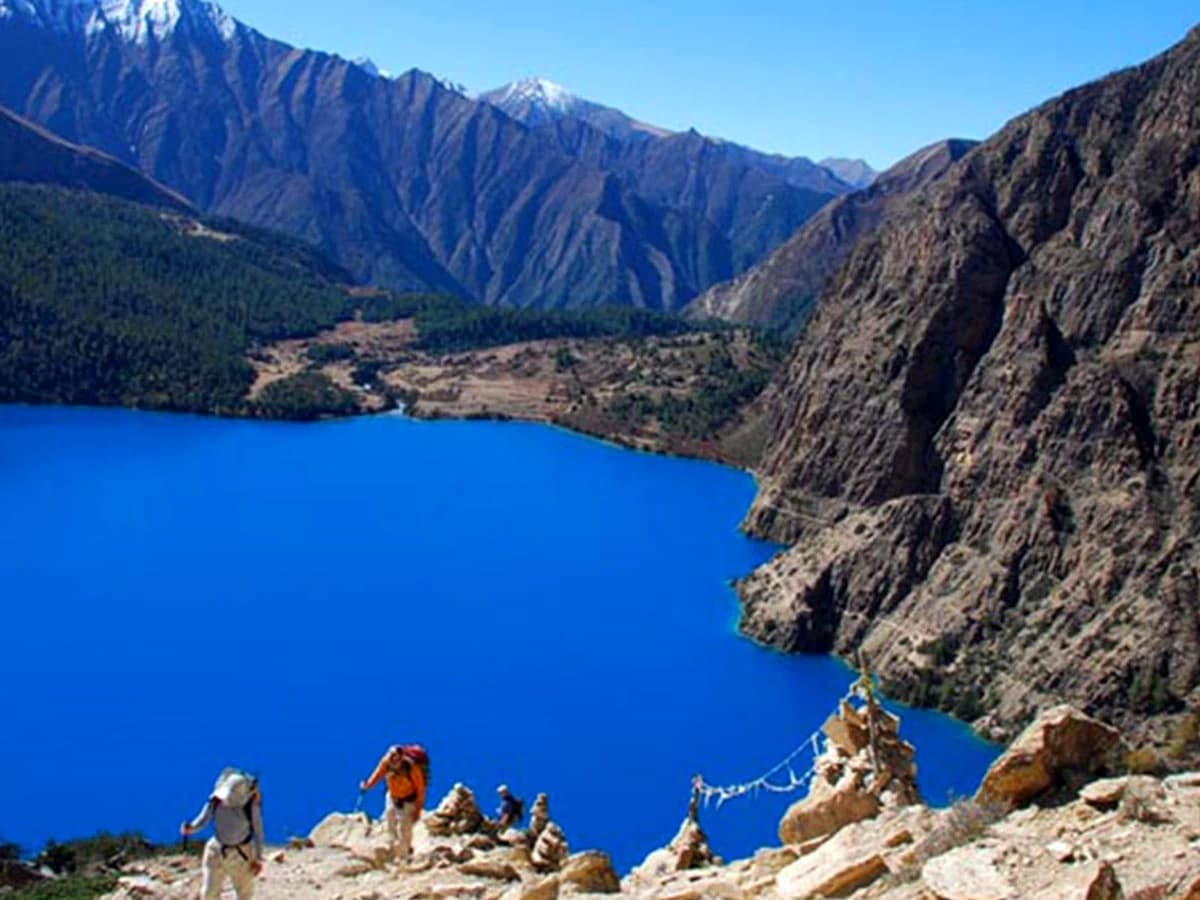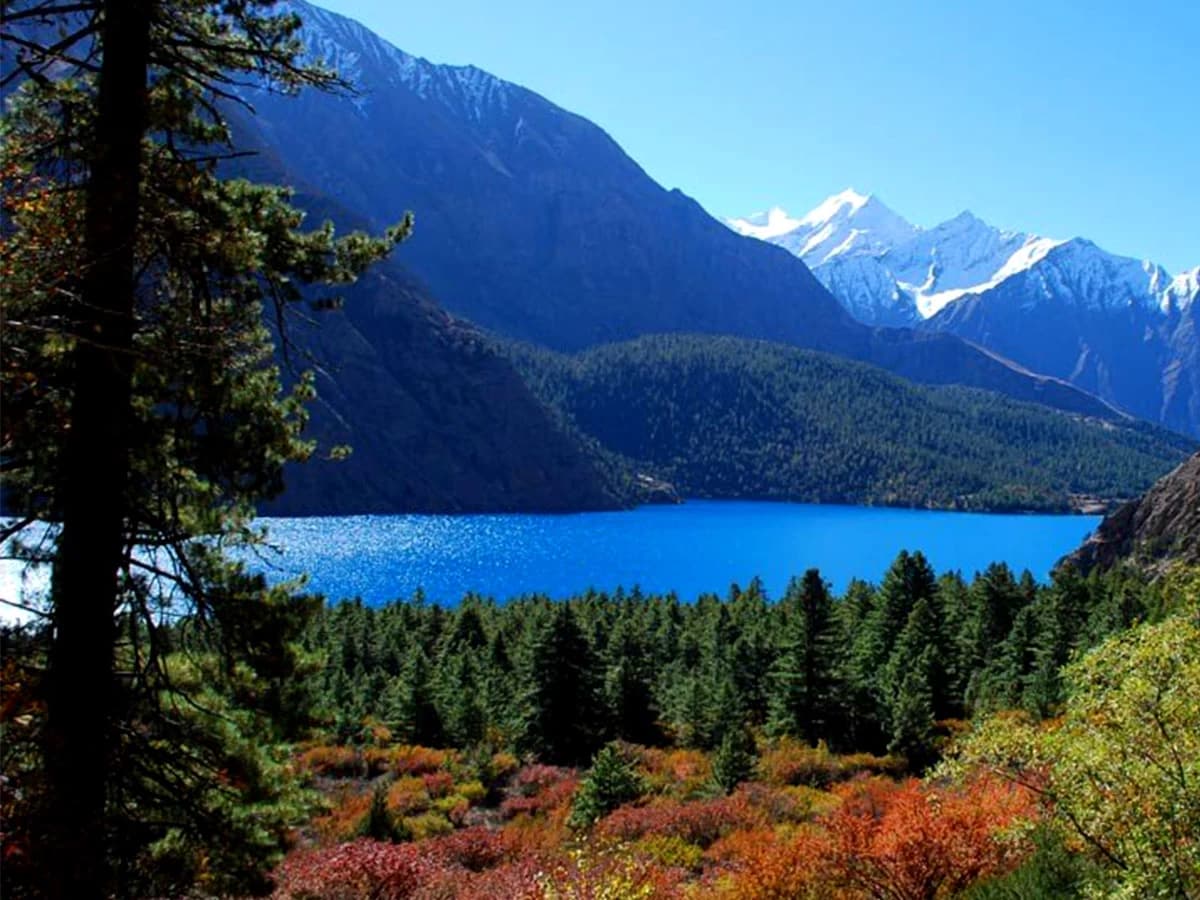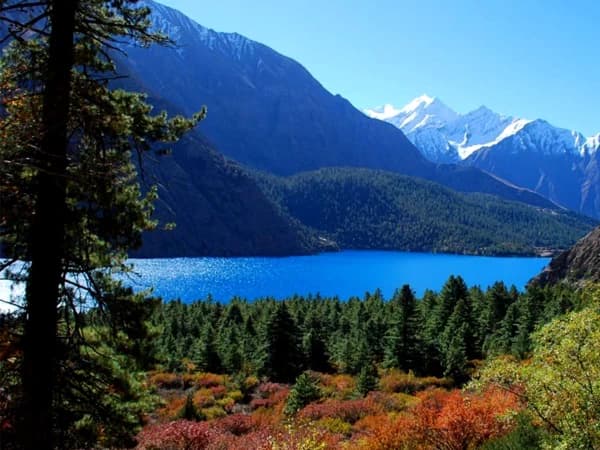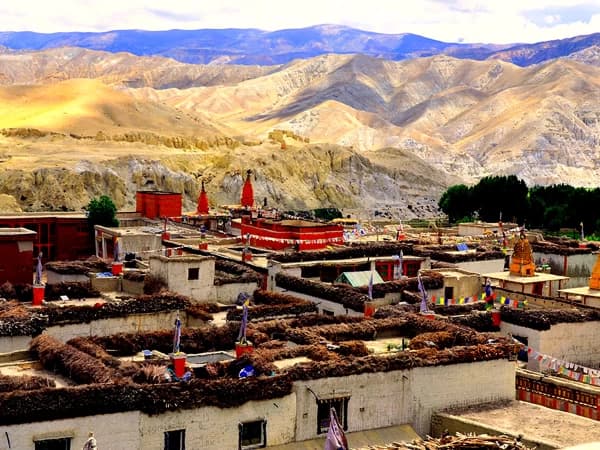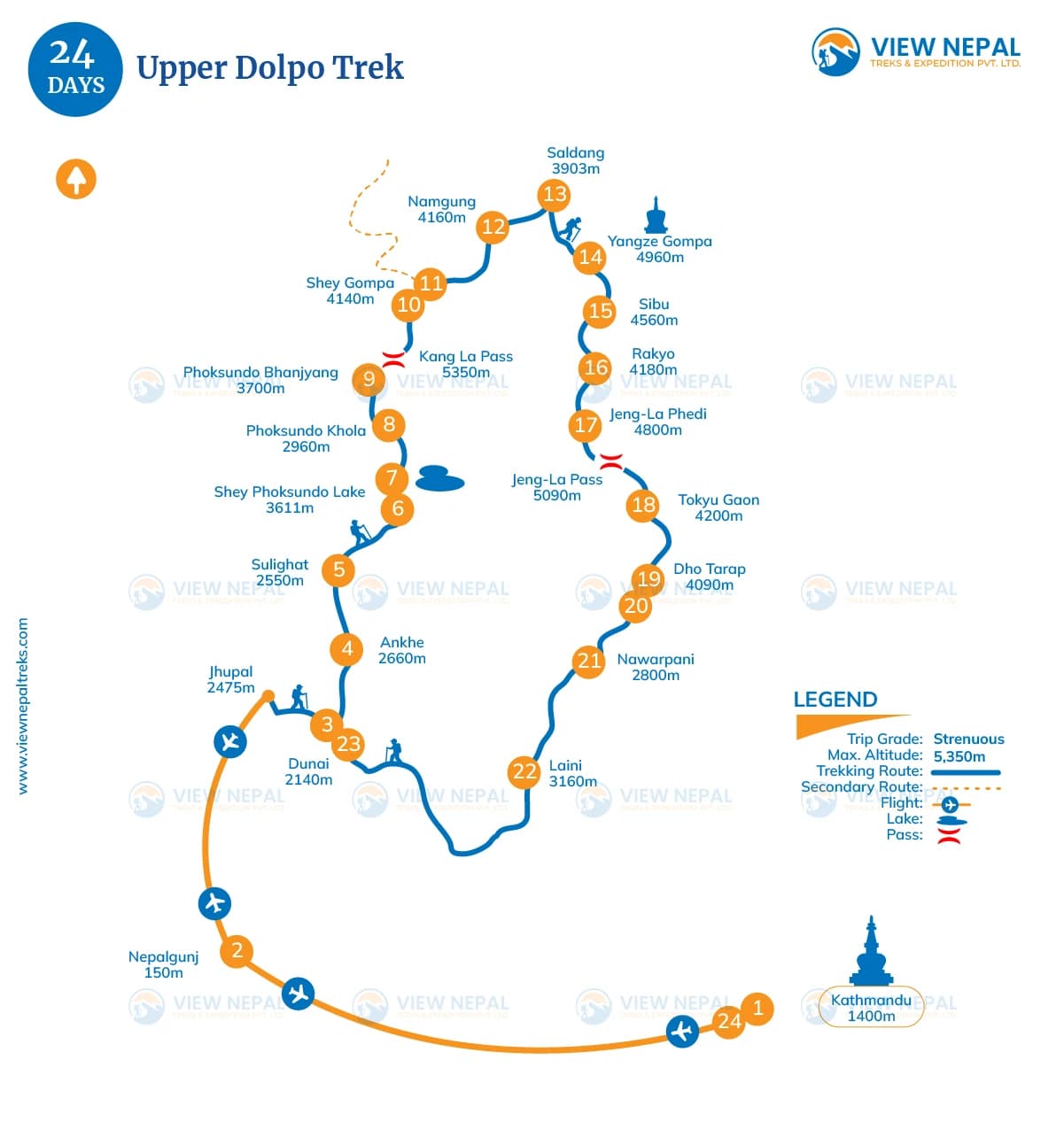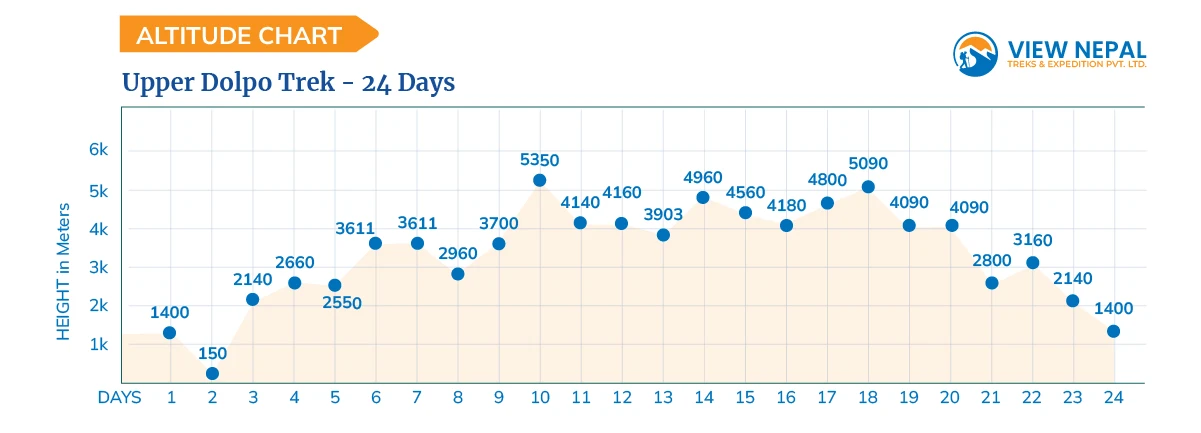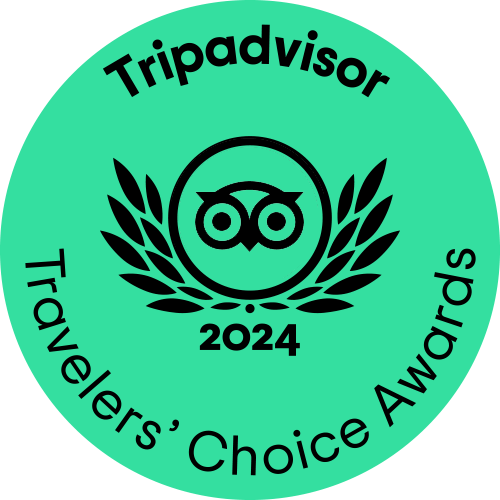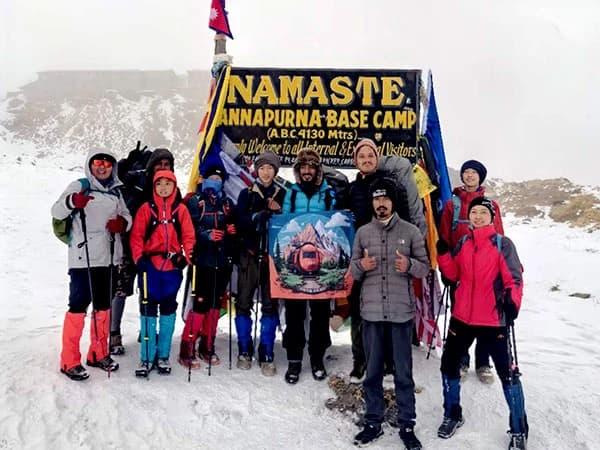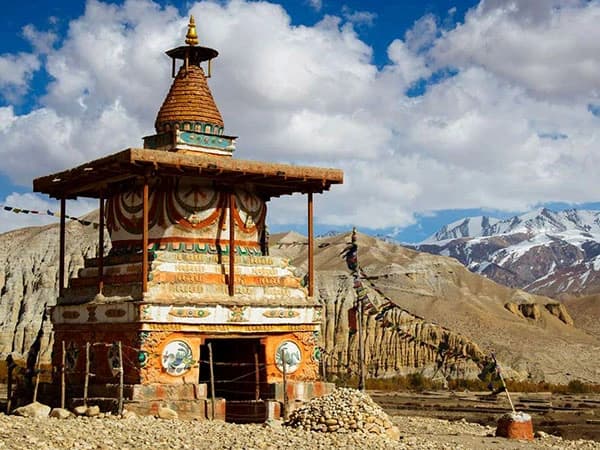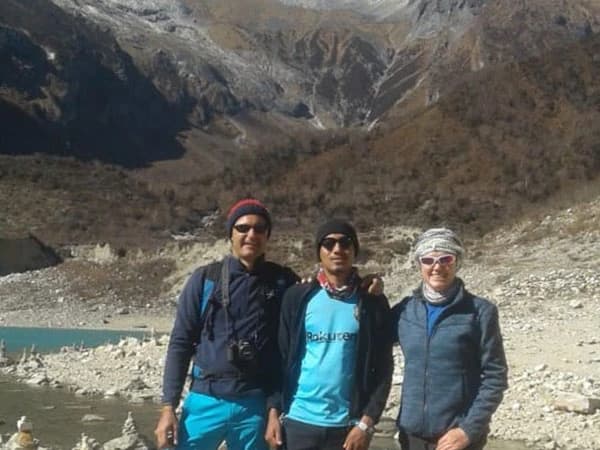The Upper Dolpo Trek is an extraordinary journey into one of Nepal’s most remote and mystical regions. Nestled in the far northwest, Dolpa is known for its wild landscapes, Tibetan culture, and spiritual allure. The trek takes adventurers through ancient monasteries, high-altitude passes, and serene valleys, providing a rare glimpse into the traditions of Tibetan Buddhism and the pristine natural beauty of Nepal.
One of the crown jewels of the Upper Dolpo Trek is Shey Phoksundo Lake, a breathtaking turquoise lake nestled at an elevation of 3,611 meters within Shey Phoksundo National Park. Known for its crystal-clear waters, the lake is a sight to behold, with dramatic cliffs surrounding it and reflecting on its still surface.
The nearby Ringmo Village offers trekkers a chance to experience traditional Tibetan culture, and the Tshowa Gompa (monastery) perched above the lake adds a spiritual dimension to this serene landscape. As a sacred site, Shey Phoksundo is revered by locals, and it’s considered one of the most beautiful places in Nepal.
The Shey Gompa, also known as the Crystal Monastery, is another major highlight of the trek. This ancient monastery, established in the 11th century, is set against the mystical Crystal Mountain. The area is of significant spiritual importance, as it is a place of pilgrimage for Buddhists who perform the traditional “Kora,” or circumambulation, around Crystal Mountain to receive blessings.
The trek to Shey Gompa includes crossing the challenging Kang La Pass (5,350 meters), providing trekkers with sweeping views of the Dolpo region. Visiting Shey Gompa is an experience filled with history and spirituality, offering a glimpse into the devotion and beliefs of Tibetan Buddhism.
Upper Dolpo is one of the few places where traditional Tibetan culture has remained largely untouched by modernity. Villages like Saldang, Dho Tarap, and Namgung provide insights into the unique lifestyle of the Dolpa people, whose Tibetan ancestry is evident in their language, clothing, and customs.
In these villages, trekkers encounter people who practice a unique, syncretic form of Bon and Tibetan Buddhism, reflecting Dolpa's cultural depth and resilience. Trekkers have the chance to interact with locals, visit ancient monasteries, and observe a way of life that has remained unchanged for centuries, making Dolpa a living museum of Tibetan culture.
The trek through Upper Dolpa is challenging, with numerous high-altitude passes that offer some of the most awe-inspiring views in the Himalayas. Trekkers will cross passes such as the Kang La (5,350 meters) and the Jeng La (5,090 meters), which provide panoramic vistas of the Dhaulagiri range and the rugged, barren landscape of Dolpa.
The terrain is characterized by arid valleys, high-altitude deserts, snow-capped peaks, and vast open spaces that make Dolpa feel like an otherworldly wilderness. This landscape, often likened to Tibet due to its high plateau geography, provides a truly unique trekking experience that stands apart from other regions in Nepal.
The Shey Phoksundo National Park is Nepal's largest national park, covering over 3,555 square kilometers, and is home to rare wildlife species that thrive in its high-altitude environment. Trekkers might spot blue sheep, musk deer, Himalayan marmots, and even the elusive snow leopard, known as the "ghost of the mountains."
The park also hosts various bird species, including Himalayan griffons and golden eagles. For nature enthusiasts, the Upper Dolpa trek offers the chance to witness these creatures in one of the most undisturbed habitats in the Himalayas.
The Upper Dolpa Trek is both a spiritual journey and a physical challenge, attracting trekkers who seek solitude, inspiration, and adventure. Due to the high altitudes, remote paths, and limited facilities, this trek is recommended for experienced trekkers prepared for a demanding experience.
Yet, the challenges of altitude and rugged terrain are offset by the rewards of spectacular scenery, cultural encounters, and a sense of timelessness unique to Dolpa.
In summary, the Upper Dolpa Trek is an immersive adventure into a world where nature and spirituality blend seamlessly. From sacred lakes and monasteries to rare wildlife and ancient Tibetan culture, this trek offers a journey as much inward as it is outward. For those seeking a truly off-the-beaten-path experience in the Himalayas, Upper Dolpa provides a remarkable and unforgettable experience.
Highlights
- Dramatic landscapes, including the pristine Phoksundo Lake, high-altitude passes, and rugged valleys surrounded by snow-capped peaks.
- A glimpse into Tibetan Buddhist traditions, with ancient monasteries like Shey Gompa and traditional villages.
- Opportunity to spot rare wildlife such as the snow leopard, blue sheep, and various bird species in the Shey Phoksundo National Park.
- High-altitude passes like Jeng La Pass (5,090m) and remote trails, make it a trek for experienced adventurers.
- Interaction with local communities, including the Dolpo people, who follow a unique Tibetan culture.
- A sense of isolation and exploration, as Upper Dolpa is one of the most remote and least accessible trekking regions in Nepal.
- Panoramic views of the Himalayas, including peaks like Kanjirowa Himal and the Dhaulagiri range.
- This trek combines natural beauty, cultural immersion, and physical challenge, making it one of the most rewarding yet demanding trekking experiences in Nepal.
Cost of Upper Dolpa Trek
The cost of a basic Upper Dolpa Trek typically ranges from USD 2,000 to 2,500. This includes:
- Permits (Restricted Area and Trekking Permits).
- Guide and porter fees.
- Domestic flights (Kathmandu to Nepalgunj, Nepalgunj to Juphal).
- Accommodation in teahouses or local lodges.
- Meals during the trek.
- Transportation (private vehicle for airport transfers in Kathmandu and Nepalgunj).
- First aid kit and basic insurance coverage.
- Additional costs may include personal equipment, tips for staff, and travel insurance.
Who is suitable for Trek?
The Upper Dolpa Trek is suitable for:
- Experienced trekkers: Due to its challenging terrain, high altitudes, and long trekking days.
- Adventurous travelers: Those seeking a remote, off-the-beaten-path adventure in Nepal.
- Physically fit individuals: Those with good endurance and stamina, as the trek involves long, strenuous days at high altitudes.
- Culturally curious trekkers: Those interested in Tibetan culture, as the trek offers insights into local traditions and monasteries.
- Nature lovers: Those who enjoy rugged landscapes, wildlife, and scenic views of the Himalayas.
- It is not recommended for beginners or those unaccustomed to high-altitude trekking.
What Can You Expect From Upper Dolpa Trek?
- Breathtaking Scenery: Stunning views of snow-capped peaks, rugged landscapes, and remote valleys, including the iconic Phoksundo Lake.
- Challenging Terrain: High-altitude passes like Jeng La Pass (5,090m) with steep ascents, rocky trails, and remote routes.
- Tibetan Culture: Interact with local communities and visit ancient monasteries such as Shey Gompa, where you can experience Tibetan Buddhism and local traditions.
- Wildlife Sightings: Opportunities to spot rare animals like snow leopards, blue sheep, and various bird species.
- Physical Challenge: Long trekking days, altitude-related challenges, and a remote environment, make it ideal for seasoned trekkers.
- Isolation: A sense of adventure and solitude in one of Nepal’s most remote trekking regions.
- Cultural Immersion: Visits to Tibetan-style villages and an opportunity to learn about the unique way of life of the Dolpo people.
Why Trek with Us?
Trek with us because we offer:
- Expert Guides: Experienced, knowledgeable guides who ensure safety, provide cultural insights, and enhance your trekking experience.
- Personalized Service: Tailored itineraries that match your preferences and skill level for a comfortable, fulfilling journey.
- Safety First: Comprehensive safety measures, including well-planned acclimatization and a focus on health and emergency preparedness.
- Authentic Experiences: Immersive cultural and natural experiences, with visits to remote villages, monasteries, and stunning landscapes.
- Reliable Support: Dedicated porters and support staff ensure smooth logistics, allowing you to focus on the adventure.
- Local Impact: Commitment to sustainable travel practices that benefit local communities and preserve the environment.
Trekking with us ensures a safe, enjoyable, and unforgettable journey in Nepal’s stunning Upper Dolpa region.

